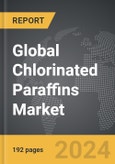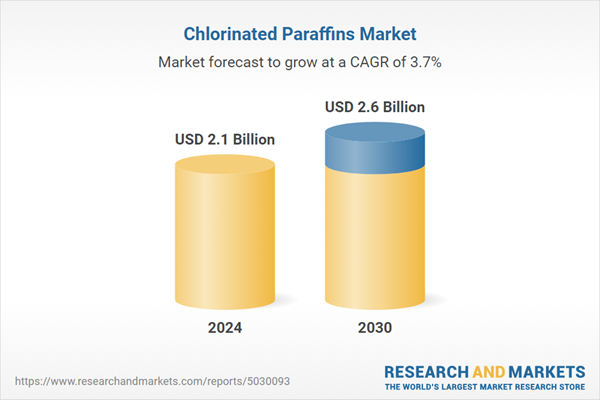The global market for Chlorinated Paraffins was valued at US$2.1 Billion in 2024 and is projected to reach US$2.6 Billion by 2030, growing at a CAGR of 3.7% from 2024 to 2030. This comprehensive report provides an in-depth analysis of market trends, drivers, and forecasts, helping you make informed business decisions. The report includes the most recent global tariff developments and how they impact the Chlorinated Paraffins market.
Segments: End-Use (Lubricating Additives, Metal Working Fluids, Plastic Additives, Paints, Rubber, Other End-Uses).
Geographic Regions/Countries: World; United States; Canada; Japan; China; Europe (France; Germany; Italy; United Kingdom; Spain; Russia; and Rest of Europe); Asia-Pacific (Australia; India; South Korea; and Rest of Asia-Pacific); Latin America (Argentina; Brazil; Mexico; and Rest of Latin America); Middle East (Iran; Israel; Saudi Arabia; United Arab Emirates; and Rest of Middle East); and Africa.
The analysts continuously track trade developments worldwide, drawing insights from leading global economists and over 200 industry and policy institutions, including think tanks, trade organizations, and national economic advisory bodies. This intelligence is integrated into forecasting models to provide timely, data-driven analysis of emerging risks and opportunities.
Global Chlorinated Paraffins Market - Key Trends and Drivers Summarized
Why Are Chlorinated Paraffins Indispensable in Modern Industries?
Chlorinated paraffins, a group of synthetic chemicals derived from the chlorination of paraffin hydrocarbons, have become crucial components in several industrial applications. What exactly makes these compounds so irreplaceable? Chlorinated paraffins possess unique properties that set them apart as excellent flame retardants, lubricants, and plasticizers. Their high chlorine content allows them to act as effective fire suppressants when added to plastics, rubbers, and textiles, providing crucial fire resistance in materials used in construction, electrical, and automotive industries. Additionally, they serve as secondary plasticizers, enhancing the flexibility and durability of products like PVC, vinyl flooring, and insulation materials. Beyond this, their low volatility and chemical stability make chlorinated paraffins particularly useful in extreme conditions, such as metalworking, where they significantly reduce friction and wear in high-pressure machining processes. Their widespread applications in lubricants, coatings, adhesives, and sealants across different sectors demonstrate their versatility and highlight their essential role in modern manufacturing.How Are Chlorinated Paraffins Produced and Categorized for Specific Uses?
Chlorinated paraffins undergo a complex production process that tailors their use for specific industrial needs, but how are they categorized to meet these demands? These chemicals are typically classified by the length of their carbon chain - short-chain (C10-C13), medium-chain (C14-C17), and long-chain (C18-C30) - with each type offering different properties. Short-chain chlorinated paraffins (SCCPs), for example, are primarily used in flame retardants and metalworking fluids, while medium- and long-chain paraffins are preferred in applications like coatings, plastics, and sealants due to their superior plasticizing effects. The level of chlorination, ranging between 30% and 70%, further influences their functionality. Higher chlorine content provides greater flame retardancy and moisture resistance, making them ideal for use in construction materials and plastics exposed to harsh environments. However, the use of SCCPs has been increasingly regulated or banned in many regions due to concerns over environmental persistence and toxicity, prompting a shift towards medium- and long-chain alternatives. These advancements in production and categorization ensure that chlorinated paraffins remain versatile and adaptable across a variety of industries, while also addressing safety and environmental concerns.Where Do Chlorinated Paraffins Find Their Most Critical Applications?
Chlorinated paraffins are a cornerstone in various industries, but what are the primary applications that drive their demand? One of the most significant uses is in metalworking fluids, where chlorinated paraffins enhance lubrication, reduce wear, and improve the thermal stability of machinery during high-intensity processes like cutting, grinding, and drilling. Their ability to remain stable under extreme heat and pressure makes them indispensable in the manufacturing of automotive and aerospace components. Another critical application is in flame retardancy, where chlorinated paraffins are added to plastics, rubbers, and textiles to increase fire resistance, particularly in building materials, electrical wiring, and upholstery. In the construction industry, they are used in paints, coatings, and adhesives, contributing to moisture resistance and durability. Chlorinated paraffins also find use in the rubber industry as plasticizers, improving the flexibility and lifespan of rubber products like hoses, belts, and seals. Even in textiles, they are applied to enhance water resistance and flame retardancy, demonstrating their wide-ranging impact across multiple sectors. These applications showcase the essential role chlorinated paraffins play in enhancing product performance, safety, and longevity.What Is Fueling the Expansion of the Chlorinated Paraffins Market?
The surge in the chlorinated paraffins market is driven by several key factors related to industrial advancements, regulatory shifts, and evolving consumer demands. First and foremost, the rising need for flame-retardant materials in sectors such as construction, automotive, and electronics is a major growth driver. As fire safety regulations become more stringent worldwide, manufacturers are turning to chlorinated paraffins for their cost-effective and efficient flame-retardant properties. The automotive and aerospace industries also rely heavily on metalworking fluids, where chlorinated paraffins provide superior lubrication and heat stability during precision machining operations. Technological advancements in the production of medium- and long-chain chlorinated paraffins have further accelerated market growth, particularly as these alternatives are viewed as safer and more environmentally friendly compared to the heavily regulated short-chain variants. Additionally, the global construction boom, particularly in developing markets, has spurred demand for chlorinated paraffins in paints, coatings, and sealants used in infrastructure projects. Regulatory changes, such as the tightening of fire safety standards and environmental restrictions, are pushing manufacturers to innovate and produce higher-quality, compliant chlorinated paraffins, fostering further market expansion. These factors are creating a strong foundation for the continued growth of the chlorinated paraffins market across multiple industries.Report Scope
The report analyzes the Chlorinated Paraffins market, presented in terms of units. The analysis covers the key segments and geographic regions outlined below.Segments: End-Use (Lubricating Additives, Metal Working Fluids, Plastic Additives, Paints, Rubber, Other End-Uses).
Geographic Regions/Countries: World; United States; Canada; Japan; China; Europe (France; Germany; Italy; United Kingdom; Spain; Russia; and Rest of Europe); Asia-Pacific (Australia; India; South Korea; and Rest of Asia-Pacific); Latin America (Argentina; Brazil; Mexico; and Rest of Latin America); Middle East (Iran; Israel; Saudi Arabia; United Arab Emirates; and Rest of Middle East); and Africa.
Key Insights:
- Market Growth: Understand the significant growth trajectory of the Lubricating Additives End-Use segment, which is expected to reach US$833.0 Million by 2030 with a CAGR of a 4.1%. The Metal Working Fluids End-Use segment is also set to grow at 3.0% CAGR over the analysis period.
- Regional Analysis: Gain insights into the U.S. market, valued at $555.3 Million in 2024, and China, forecasted to grow at an impressive 5.7% CAGR to reach $542.8 Million by 2030. Discover growth trends in other key regions, including Japan, Canada, Germany, and the Asia-Pacific.
Why You Should Buy This Report:
- Detailed Market Analysis: Access a thorough analysis of the Global Chlorinated Paraffins Market, covering all major geographic regions and market segments.
- Competitive Insights: Get an overview of the competitive landscape, including the market presence of major players across different geographies.
- Future Trends and Drivers: Understand the key trends and drivers shaping the future of the Global Chlorinated Paraffins Market.
- Actionable Insights: Benefit from actionable insights that can help you identify new revenue opportunities and make strategic business decisions.
Key Questions Answered:
- How is the Global Chlorinated Paraffins Market expected to evolve by 2030?
- What are the main drivers and restraints affecting the market?
- Which market segments will grow the most over the forecast period?
- How will market shares for different regions and segments change by 2030?
- Who are the leading players in the market, and what are their prospects?
Report Features:
- Comprehensive Market Data: Independent analysis of annual sales and market forecasts in US$ Million from 2024 to 2030.
- In-Depth Regional Analysis: Detailed insights into key markets, including the U.S., China, Japan, Canada, Europe, Asia-Pacific, Latin America, Middle East, and Africa.
- Company Profiles: Coverage of players such as Aditya Birla Chemicals (India) Ltd., Altair Chimica SpA, Caffaro Industrie SPA, Dover Chemical Corporation, Handy Chemical Corp. Ltd. and more.
- Complimentary Updates: Receive free report updates for one year to keep you informed of the latest market developments.
Some of the 38 companies featured in this Chlorinated Paraffins market report include:
- Aditya Birla Chemicals (India) Ltd.
- Altair Chimica SpA
- Caffaro Industrie SPA
- Dover Chemical Corporation
- Handy Chemical Corp. Ltd.
- INEOS Group Ltd.
- Inovyn
- KLJ Group
- Leuna-Tenside GmbH
- Quimica del Cinca SLU
Tariff Impact Analysis: Key Insights for 2025
Global tariff negotiations across 180+ countries are reshaping supply chains, costs, and competitiveness. This report reflects the latest developments as of April 2025 and incorporates forward-looking insights into the market outlook.The analysts continuously track trade developments worldwide, drawing insights from leading global economists and over 200 industry and policy institutions, including think tanks, trade organizations, and national economic advisory bodies. This intelligence is integrated into forecasting models to provide timely, data-driven analysis of emerging risks and opportunities.
What’s Included in This Edition:
- Tariff-adjusted market forecasts by region and segment
- Analysis of cost and supply chain implications by sourcing and trade exposure
- Strategic insights into geographic shifts
Buyers receive a free July 2025 update with:
- Finalized tariff impacts and new trade agreement effects
- Updated projections reflecting global sourcing and cost shifts
- Expanded country-specific coverage across the industry
Table of Contents
I. METHODOLOGYII. EXECUTIVE SUMMARY2. FOCUS ON SELECT PLAYERSIII. MARKET ANALYSISSOUTH KOREAREST OF ASIA-PACIFICARGENTINABRAZILMEXICOREST OF LATIN AMERICAIRANISRAELSAUDI ARABIAUNITED ARAB EMIRATESREST OF MIDDLE EASTIV. COMPETITION
1. MARKET OVERVIEW
3. MARKET TRENDS & DRIVERS
4. GLOBAL MARKET PERSPECTIVE
UNITED STATES
CANADA
JAPAN
CHINA
EUROPE
FRANCE
GERMANY
ITALY
UNITED KINGDOM
SPAIN
RUSSIA
REST OF EUROPE
ASIA-PACIFIC
AUSTRALIA
INDIA
LATIN AMERICA
MIDDLE EAST
AFRICA
Companies Mentioned (Partial List)
A selection of companies mentioned in this report includes, but is not limited to:
- Aditya Birla Chemicals (India) Ltd.
- Altair Chimica SpA
- Caffaro Industrie SPA
- Dover Chemical Corporation
- Handy Chemical Corp. Ltd.
- INEOS Group Ltd.
- Inovyn
- KLJ Group
- Leuna-Tenside GmbH
- Quimica del Cinca SLU
Table Information
| Report Attribute | Details |
|---|---|
| No. of Pages | 192 |
| Published | April 2025 |
| Forecast Period | 2024 - 2030 |
| Estimated Market Value ( USD | $ 2.1 Billion |
| Forecasted Market Value ( USD | $ 2.6 Billion |
| Compound Annual Growth Rate | 3.7% |
| Regions Covered | Global |









